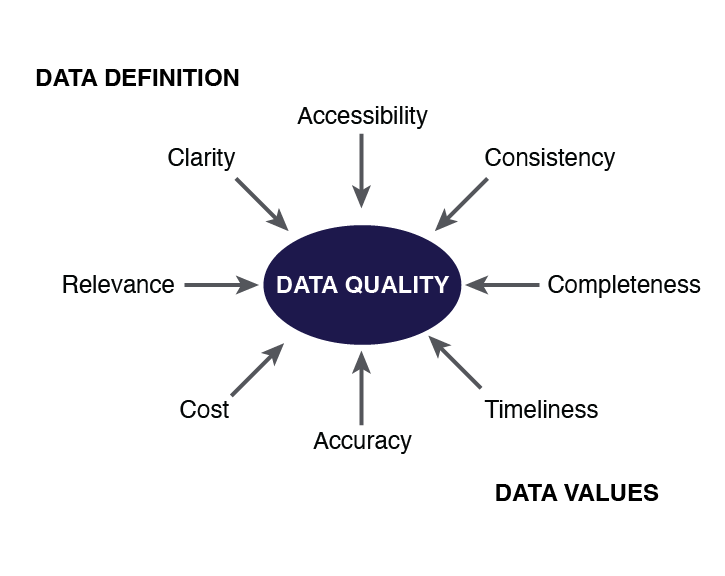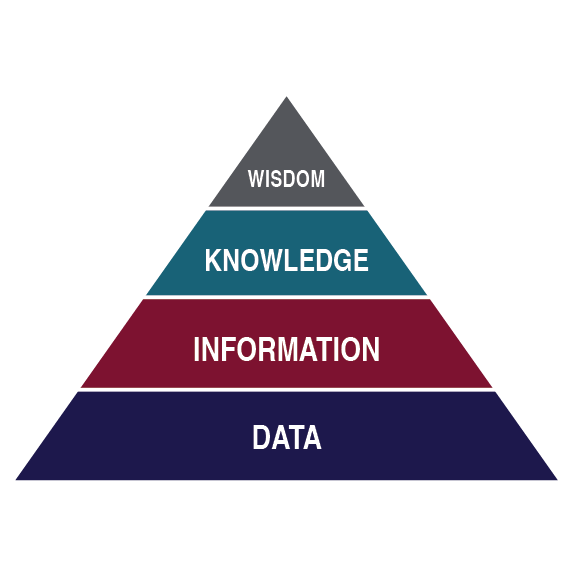1.4. The Role of Information Systems
The goal of an information system is to transform data into information in order to generate knowledge that can be used for decision making. In order for information to add value to a business and the decision maker it must possess characteristics to ensure quality. The following characteristics are necessary to add value.

| Accessible | Must be easily accessible by users to meet their needs in the right format at the right time. Access should be secure and prevent unauthorized access. |
| Consistent | Contains no discrepancies, and the same measurements or structure are used regardless of the data source. |
| Complete | Contains all information and is not missing anything. |
| Timely | Delivered when needed. |
| Accurate | Free of errors and bias, and can be verified or validated. |
| Cost | Balance the value of information to the cost of producing it. |
| Relevant | Important to decision makers. |
| Clear | Not overly complex, easy to understand. |
The terms information and knowledge are sometimes used interchangeably. What is the difference between data, information and knowledge?
Data, Information, Knowledge, & Wisdom

Data are the raw facts, and may be devoid of context or intent. For example, a sales order is a piece of data. Data can be quantitative or qualitative. Quantitative data is numeric, the result of a measurement, count, or some other mathematical calculation. Qualitative data is descriptive. “Ruby Red,” the color of a 2013 Ford Focus, is an example of qualitative data. A number can be qualitative too: if I tell you my favorite number is 5, that is qualitative data because it is descriptive, not the result of a measurement or mathematical calculation.
Information is processed data that possess context, relevance, and purpose. For example, monthly sales calculated from the collected daily sales data for the past year are information. Information typically involves the manipulation of raw data to obtain an indication of magnitude, trends, in patterns in the data for a purpose.
Example: Student Evaluations
As an example, suppose that you want to know how you’re doing in a particular course. So far, you’ve taken two 20-question multiple-choice tests. On the first, you got questions 8, 11, and 14 wrong; on the second, you did worse, missing items 7, 15, 16, and 19. The items that you got wrong are merely data—unprocessed facts. What’s important is your total score. You scored 85 on the first exam and 80 on the second. These two numbers constitute information—data that have been processed, or turned into some useful form. Knowing the questions that you missed simply supplied you with some data for calculating your scores.
Now let’s fast-forward to the end of the semester. At this point, in addition to taking the two tests, you’ve written two papers and taken a final. You scored a 90 and 95 on the papers and a 90 on the final. You now have more processed data, but you still want to organize them into more useful information. What you want to know is your average grade for the semester. To get the information you want, you need yet more data—namely, the weight assigned to each graded item. Fortunately, you’ve known from day one that each test counts 20 percent, each paper 10 percent, and the final exam 40 percent. A little math reveals an average grade of 87.
Though this is the information you are interested in, it may be mere data to your instructor, who may want different information: for example, the average grade for the entire class. The moral of the story is that what constitutes information at one stage can easily become data at another, and one person’s information can be another person’s data.
Knowledge in a certain area is human beliefs or perceptions about relationships among facts or concepts relevant to that area. For example, the conceived relationship between the quality of goods and the sales is knowledge. Knowledge can be viewed as information that facilitates action.
Once we have put our data into context, aggregated and analyzed it, we can use it to make decisions for our organization. We can say that this consumption of information produces knowledge. This knowledge can be used to make decisions, set policies, and even spark innovation.
Explicit knowledge typically refers to knowledge that can be expressed in words or numbers. In contrast, tacit knowledge includes insights and intuitions and is difficult to transfer to another person using simple communication. When information or explicit knowledge is captured and stored in a computer, it would become data if the context or intent is devoid.
We can say that someone has wisdom when they can combine their knowledge and experience to produce a deeper understanding of a topic. It often takes many years to develop wisdom on a particular topic, and requires patience.
“Chapter 4: Data and Databases” from Information Systems for Business and Beyond (2019) by David Bourgeois is licensed under a Creative Commons Attribution-NonCommercial 4.0 International License, except where otherwise noted.
Student Evaluation Example from Chapter 15: Managing Information and Technology from Maritime Management: Micro and Small Businesses by Matthew Pauley is licensed under a Creative Commons Attribution-NonCommercial-ShareAlike 4.0 International License, except where otherwise noted.

